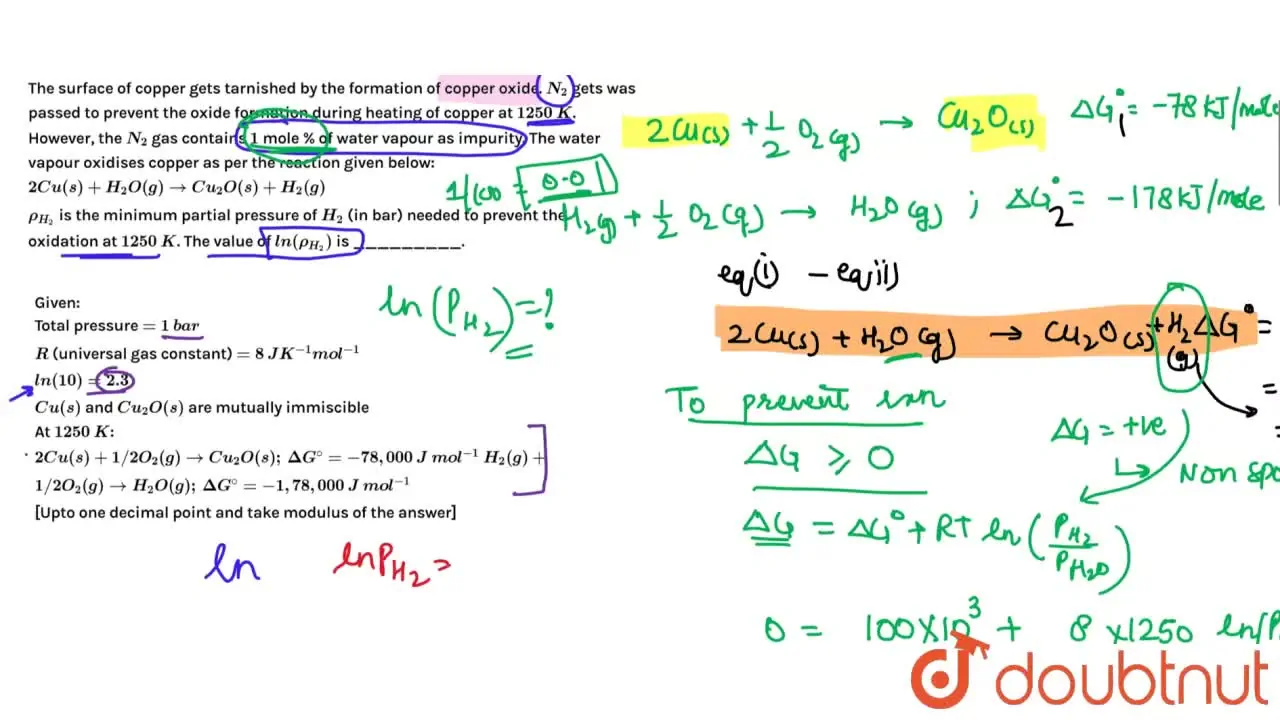The surface of copper gets tarnished by the formation of copper oxide. N2 gas was passed to prevent the oxide formation during heating of copper at 1250 K. However, the N2 gas contains 1 mole % of water vapour as impurity. The water vapour oxidises copper as per the reaction given below: 2Cu(s)+H2O(g)→Cu2O(s)+H2(g) is the minimum partial pressure of H2 (in bar) needed to prevent the oxidation at 1250 K. The value of ln is ____. (Given: total pressure = 1 bar, R (universal gas constant) = 8JK−1mol−1,ln(10)=2.3.Cu(s)andCu2O(s) are mutually immiscible. At 1250 K:2Cu(s)+1/2O2(g)→Cu2O(s)
△Hθ=−78,000Jmol−1
H2(g)+1/2O2(g)→H2O(g),△Gθ=−1,78,000Jmol−1, G is the Gibbs energy
Step by step video & image solution for The surface of copper gets tarnished by the formation of copper oxide. N_(2) gas was passed to prevent the oxide formation during heating of copper at 1250 K. However, the N_(2) gas contains 1 mole % of water vapour as impurity. The water vapour oxidises copper as per the reaction given below: 2Cu(s) + H_(2)O(g) rarr Cu_(2)O(s) + H_(2)(g) is the minimum partial pressure of H2 (in bar) needed to prevent the oxidation at 1250 K. The value of ln is ____. (Given: total pressure = 1 bar, R (universal gas constant) = 8 J K−1 mol^(−1), ln(10) = 2.3. Cu(s) and Cu_(2)O(s) are mutually immiscible. At 1250 K: 2Cu(s) + 1//2 O_(2)(g) rarr Cu_(2)O(s) triangle H^(theta) = − 78,000 J mol^(−1) H_(2)(g) + 1//2 O_(2)(g) rarr H_(2)O(g), triangle G^(theta) = − 1,78,000 J mol^(−1), G is the Gibbs energy by Chemistry experts to help you in doubts & scoring excellent marks in Class 12 exams.
Related Playlists
- BOOK - JEE ADVANCED PREVIOUS YEARCHAPTER - JEE ADVANCEDEXERCISE - SECTION-I (Single Correct Choice Type )12videos
JEE ADVANCED
- BOOK - JEE ADVANCED PREVIOUS YEARCHAPTER - JEE ADVANCEDEXERCISE - SECTION-II(Multiple Correct Choice Type )4videos
JEE ADVANCED
- BOOK - JEE ADVANCED PREVIOUS YEARCHAPTER - JEE ADVANCEDEXERCISE - CHEMISTRY SECTION - IV : Matric Match Type2videos
JEE ADVANCED
- BOOK - JEE ADVANCED PREVIOUS YEARCHAPTER - JEE (ADVANCED ) 2020EXERCISE - SECTION -III6videos
JEE (ADVANCED ) 2020
- BOOK - JEE ADVANCED PREVIOUS YEARCHAPTER - JEE ADVANCED 2020EXERCISE - SECTION-36videos
JEE ADVANCED 2020
Similar Questions
The surface of copper gets tarnished by the formation of copper oxide. N2 gas was passed to prevent the oxide formation during heating of copper at 1250 K. However, the N2 gas contains 1 mole % of water vapour as impurity. The water vapour oxidises copper as per the reaction given below: 2Cu(s)+H2O(g)→Cu2O(s)+H2(g) is the minimum partial pressure of H2 (in bar) needed to prevent the oxidation at 1250 K. The value of ln is ____. (Given: total pressure = 1 bar, R (universal gas constant) = 8JK−1mol−1,ln(10)=2.3.Cu(s)andCu2O(s) are mutually immiscible. At 1250 K:2Cu(s)+1/2O2(g)→Cu2O(s)
△Hθ=−78,000Jmol−1
H2(g)+1/2O2(g)→H2O(g),△Gθ=−1,78,000Jmol−1, G is the Gibbs energyView SolutionThe surface of copper gets tarnished by the formation of copper oxide. N2 gas was passed to prevent the oxide formation during heating of copper at 1250 K. However, the N2 gas contains 1 mole % of water vapour as impurity. The water vapour oxidises copper as per the reaction given below: 2Cu(s)+H2O(g)→Cu2O(s)+H2(g) is the minimum partial pressure of H2 (in bar) needed to prevent the oxidation at 1250 K. The value of ln is ____. (Given: total pressure = 1 bar, R (universal gas constant) = 8JK−1mol−1,ln(10)=2.3.Cu(s)andCu2O(s) are mutually immiscible. At 1250 K:2Cu(s)+1/2O2(g)→Cu2O(s)
△Hθ=−78,000Jmol−1
H2(g)+1/2O2(g)→H2O(g),△Gθ=−1,78,000Jmol−1, G is the Gibbs energyView SolutionThe surface of copper gets tarnished by the formation of copper oxide. N2 gas was passed to prevent the oxide formation during heating of copper at 1250 K. However, the N2 gas contains 1 mole per cent of water vapour as impurity. The water vapour oxidises copper as par the reaction given below:
2Cu(s)+H2O(g)→Cu2O(s)+H2(g)
pH2 is the minimum partical pressure of H2 (1 bar) needed to prevent the oxidation at 1250 K. The value of In(PH2 is... [Given: Total pressure =1 bar]
R (universal gas constant) =8JK−1 mol−1,In(10)=2.3, Cu(s) and Cu2O(s) are mutually immiscible.
At 1250K:2Cu(s)+12O2(g)→Cu2O(s),△G∘=−78000Jmol−1
H2(g)+12O2(g)→H2O,△G∘=−1,78,000Jmol−1View SolutionIdentify oxidant in reaction given below :
CuO(s)+H2(g)→Cu(s)+H2O(g)View SolutionIdentify the substances that are oxidised and the substances that are reduced in the following reactions.
CuO(s)+H2(g)→Cu(s)+H2O(l)View SolutionIdentify the substances that are oxidised and the substances that are reduced in the following reactions.
(i) 4Na(s)+O2(g)→2NaO(s)
(ii) CuO(g)+H2(g)→Cu(s)+H2O(l)View SolutionStatement 1: CuSO4.5H2O(s)⇔CuSO4.3H2O(s)+2H2O(g). For this equlibrium partial pressure of H2O(g) increases continously with increasing volume.
Statement 2: Vapour pressure depends only on temperarture.View SolutionIn the formation of methane from water gas CO(g)+3H2<⇒CH4(G)+H2O(g), if the water vapour is removed from the reaction mixture
View SolutionH2S(gas) initially at a pressure of 10.0 atm and a temperature of 800K dissociates as 2H2S(g) ↔2H2(g) + S2(g) . At equilibrium, the partial pressure of S2 vapour is 0.020 atm Thus Kp is
View SolutionGiven that -
2C(s)+2O2(g)→2CO2(g)ΔH=−787KJ
H2(g)+1/2O2(g)→H2O(l)Δ=−286KJ
C2H2(g)+52O2(g)→H2O(l)ΔH=−1310KJ
Heat of formation of acetylene is :-View Solution


